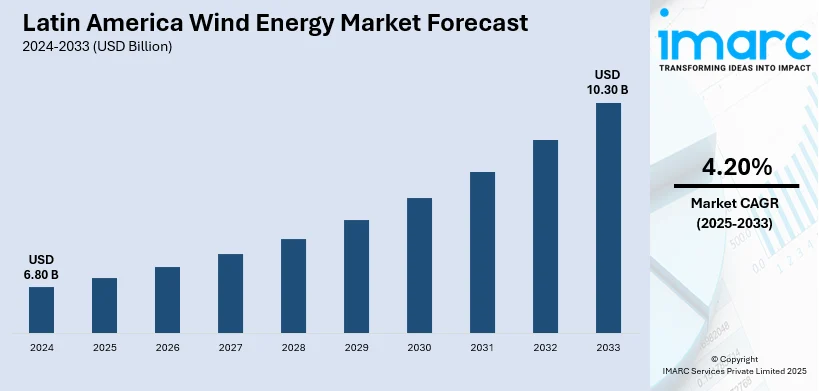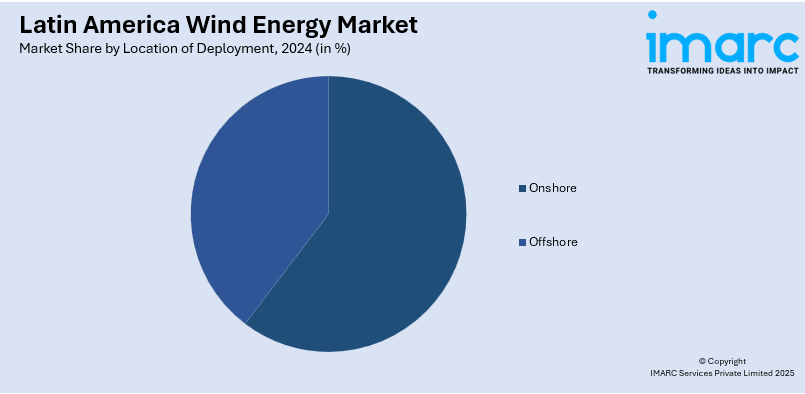
Latin America Wind Energy Market Size, Share, Trends and Forecast by Location of Deployment, and Region, 2025-2033
Latin America Wind Energy Market Overview:
The Latin America wind energy market size reached USD 6.80 Billion in 2024. Looking forward, IMARC Group expects the market to reach USD 10.30 Billion by 2033, exhibiting a growth rate (CAGR) of 4.20% during 2025-2033. The market is expanding due to the increasing investments in renewable energy (RE) and supportive government policies. Additionally, countries like Brazil and Mexico are leading the growth in the region, with strong capacity additions. The market is set to benefit from the rising demand for clean energy and ongoing technological advancements.
|
Report Attribute
|
Key Statistics
|
|---|---|
|
Base Year
|
2024
|
|
Forecast Years
|
2025-2033
|
|
Historical Years
|
2019-2024
|
| Market Size in 2024 | USD 6.80 Billion |
| Market Forecast in 2033 | USD 10.30 Billion |
| Market Growth Rate 2025-2033 | 4.20% |
Latin America Wind Energy Market Trends:
Rise in Government Incentives and Policies
Government policies and incentives are pivotal in enhancing the Latin America wind energy market outlook. Brazil, Mexico, Argentina, and Colombia among others are among the countries taking various steps in this regard. These consist of tax credits, long-term power purchase agreements (PPAs), and also special auctions. Notably, in October 2023, Colombia initiated Latin America's inaugural auction for offshore wind projects, with deadlines extended to September and winners selected by August 2025. The country targets 7 GW of offshore wind capacity by 2040 and 13 GW by 2050. Additionally, Chile and Uruguay are making significant investments in the wind sector. Auctions such as Brazil’s A-5 and Mexico's energy reform auctions foster competitive pricing, while grid access priorities for renewables ensure their integration into national energy systems, promoting a sustainable energy mix across the region. Furthermore, certain governments in the region enable RE sources to receive priority access to the power grid which facilitates their entry into national energy systems and drives the development of sustainable energy mixes across the region. Moreover, cross-border energy agreements together with regional cooperation constitute essential methods to boost RE sharing and transmission between Latin American nations. This collaborative approach is further supported by international organizations and development banks, that are providing financial aid and technical expertise to accelerate the transition to RE is significantly driving the Latin America wind energy market growth.

Grid Integration and Expansion
The integration and expansion of grid systems are increasing the demand for wind energy in Latin America. In addition to this, the settlement of offshore wind farms involves immense investment in improvements and additions to the existing transmission infrastructure to service the new resources. Moreover, offshore wind-targeted countries are investing in their grid modernization, deploying intelligent grid technologies, and increasing the flexibility of their grids to account for the changing character of power from wind energy. This encompasses the installation of new high-capacity transmission lines, substation upgrades, and the deployment of advanced energy management systems for smooth distribution and integration of renewable power into national grids. Besides this, there are initiatives to enhance grid strength and minimize transmission losses, that are essential for providing a stable supply of energy. By strengthening their grid infrastructure, these nations efficiently incorporate large-scale wind projects, support continuous renewable energy growth, and enhance overall energy security and stability. This infrastructure enhancement facilitates current wind energy expansions and sets the foundation for future renewable initiatives, promoting a more sustainable and resilient energy landscape in the region. In August 2023, GE Vernova's Grid Solutions made plans for the supply of two 500 kV air-insulated substations (AIS) for Casa dos Ventos' Serra do Tigre Wind Complex in Brazil. The wind complex has an installed generation capacity of 756 MW and can still be used to accommodate additional production of wind power if needed, further increasing the share of wind energy in the Latin American market.
Latin America Wind Energy Market Segmentation:
IMARC Group provides an analysis of the key trends in each segment of the market, along with forecasts at the region level for 2025-2033. Our report has categorized the market based on location of deployment.
Location of Deployment Insights:

- Onshore
- Offshore
The report has provided a detailed breakup and analysis of the market based on the location of deployment. This includes onshore and offshore.
Regional Insights:
- Brazil
- Mexico
- Argentina
- Colombia
- Chile
- Peru
- Others
The report has also provided a comprehensive analysis of all the major regional markets, which include Brazil, Mexico, Argentina, Colombia, Chile, Peru, and others.
Competitive Landscape:
The market research report has also provided a comprehensive analysis of the competitive landscape. Competitive analysis such as market structure, key player positioning, top winning strategies, competitive dashboard, and company evaluation quadrant has been covered in the report. Also, detailed profiles of all major companies have been provided.
Latin America Wind Energy Market News:
- In August 2024, Scala Data Centers and Serena announced a RE supply agreement, set to begin in 2025. This partnership aims to provide wind power from Brazilian farms to meet the energy needs of hyperscale data centers, including artificial intelligence (AI) workloads. The wind power will be sourced from two farms in Bahia, Brazil, with a total capacity of 393 MW. This initiative marks a significant step in Scala's commitment to sustainability and environmental stewardship.
- In March 2024, the administrations of Brazil and Colombia made key announcements for offshore wind farms in order to boost their net-zero plans and create energy security. Brazil has 232 GW worth of offshore wind projects listed at the nation's environmental licensing office IBAMA, whereas Colombia's Offshore Wind Roadmap assumes an overall reference capacity potential of 50 GW. Legislation on both sides is supporting the progression of more definitive plans for offshore wind.
Latin America Wind Energy Market Report Coverage:
| Report Features | Details |
|---|---|
| Base Year of the Analysis | 2024 |
| Historical Period | 2019-2024 |
| Forecast Period | 2025-2033 |
| Units | Billion USD |
| Scope of the Report |
Exploration of Historical Trends and Market Outlook, Industry Catalysts and Challenges, Segment-Wise Historical and Future Market Assessment:
|
| Location of Deployments Covered | Onshore, Offshore |
| Regions Covered | Brazil, Mexico, Argentina, Colombia, Chile, Peru, Others |
| Customization Scope | 10% Free Customization |
| Post-Sale Analyst Support | 10-12 Weeks |
| Delivery Format | PDF and Excel through Email (We can also provide the editable version of the report in PPT/Word format on special request) |
Key Questions Answered in This Report:
- How has the Latin America wind energy market performed so far and how will it perform in the coming years?
- What is the breakup of the Latin America wind energy market on the basis of location of deployment?
- What is the breakup of the Latin America wind energy market on the basis of region?
- What are the various stages in the value chain of the Latin America wind energy market?
- What are the key driving factors and challenges in the Latin America wind energy?
- What is the structure of the Latin America wind energy market and who are the key players?
- What is the degree of competition in the Latin America wind energy market?
Key Benefits for Stakeholders:
- IMARC’s industry report offers a comprehensive quantitative analysis of various market segments, historical and current market trends, market forecasts, and dynamics of the Latin America wind energy market from 2019-2033.
- The research report provides the latest information on the market drivers, challenges, and opportunities in the Latin America wind energy market.
- Porter's five forces analysis assist stakeholders in assessing the impact of new entrants, competitive rivalry, supplier power, buyer power, and the threat of substitution. It helps stakeholders to analyze the level of competition within the Latin America wind energy industry and its attractiveness.
- Competitive landscape allows stakeholders to understand their competitive environment and provides an insight into the current positions of key players in the market.
Need more help?
- Speak to our experienced analysts for insights on the current market scenarios.
- Include additional segments and countries to customize the report as per your requirement.
- Gain an unparalleled competitive advantage in your domain by understanding how to utilize the report and positively impacting your operations and revenue.
- For further assistance, please connect with our analysts.
 Inquire Before Buying
Inquire Before Buying
 Speak to an Analyst
Speak to an Analyst
 Request Brochure
Request Brochure
 Request Customization
Request Customization




.webp)




.webp)












